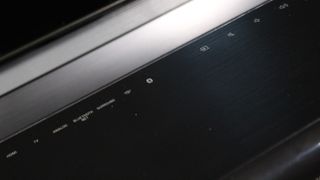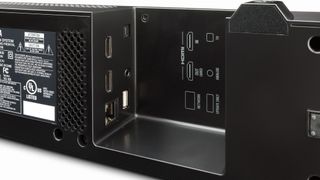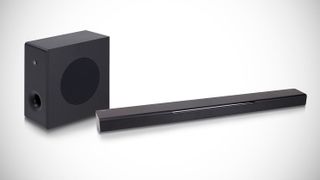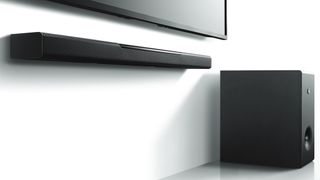TechRadar Verdict
The Yamaha BAR 400 delivers a solid 2.1-channel performance, making it ideal for both movies and music. The inclusion of MusicCast allows for multiroom support, while DTS Virtual:X delivers a more immersive experience. Yamaha certainly knows how to put together a decent soundbar, although the lack of Dolby Atmos and DTS:X support is disappointing at this price point.
Pros
- +
Great with movies and music
- +
MusicCast multiroom
- +
Sub well integrated
- +
Easy to set-up
Cons
- -
No Dolby Atmos/DTS:X
- -
One HDMI input
Why you can trust TechRadar
Yamaha has plenty of experience when it comes to soundbars so, when it releases something new in that area, expectations are high.
Thankfully, the Yamaha MusicCast BAR 400 - a 2.1-channel soundbar composed of a main unit and a wireless active subwoofer- mostly lives up to them.
The combo promises plenty of useful features including support for the MusicCast multiroom system, DTS Virtual:X, Hi-Res Audio, Apple AirPlay, and Amazon Alexa voice control. That said, however, the BAR 400 isn’t cheap at £479 ($449, AU$799), and the lack of support for immersive or even lossless audio puts it at a disadvantage to some of the competition.
Can Yamaha’s strengths in other areas compensate for this bar's weaknesses?
Design
The BAR 400 sports Yamaha’s classic minimalist approach to design, with a curved metal grille at the front and a brushed metal finish on top. The soundbar is well-made, comes in black and uses a low form factor that ensures it is unobtrusive when sat in front of your TV.
The minimalism extends to the display, which is composed of a series of simple indicator lights on the top of the soundbar - these show the selected source and surround mode, along with any Wi-Fi or Bluetooth connections. There are front left and right speakers composed of two 4.6cm woofers and a 2.5cm tweeter, with each speaker powered by 50W of amplification.
The included wireless active subwoofer is designed to match the soundbar itself, and is styled in black brushed metal. It uses a side-firing 6.5" driver combined with a bass port at the front, and there is 100W of amplification built-in. The two units should pair automatically, although there’s also the option of manual pairing if necessary.

There are some simple touch sensitive controls on the soundbar itself for source select, mute, volume up/down, and also power/connect. The included remote is rather dinky but has all the controls you’ll need to adjust the volume and subwoofer level, select inputs, and choose features like 3D Surround and Clear Voice.
Since the BAR 400 supports MusicCast, you also have the option of using the free remote app which is available for iOS and Android. This has a well-designed and highly effective user interface, making it ideal for setting up and controlling the system. This is especially helpful given the lack of any real display on the soundbar itself.
The connections are located in a recessed area on the underside of the soundbar. Here you’ll find an HDMI input, an HDMI output with ARC (Audio Return Channel), a 3.5mm auxiliary audio jack, an optical digital audio input, and an Ethernet port. In terms of wireless connections there’s Wi-Fi (2.4GHz/5GHz), Bluetooth (Ver. 4.2+EDR/A2DP, AVRCP), and Apple AirPlay.

Features

Dimensions: Soundbar – 980(w) x 60(h) x 110(d)mm; Subwoofer – 180(w) x 417(h) x 405(d)mm | Speaker configuration: 2.1 | Claimed audio power: 200W | Connections: HDMI input and output with ARC, optical digital audio input, 3.5mm audio jack, Ethernet, Wi-Fi, Bluetooth
The Yamaha BAR 400 boasts plenty of useful features, headlined by the inclusion of MusicCast, a highly effective multiroom system that allows you to create a network comprised of MusicCast-supporting devices located around the home. Similar to a Sonos system, the remote app enables you to control all these devices, streaming music to and from them.
The soundbar’s Hi-Fi credentials are further bolstered by the inclusion of Hi-Res Audio up to 24bit/192kHz, and there’s support for MP3, WAV, AAC, AIFF, WMA, Apple Lossless, and FLAC file types. There are also various popular music streaming services built-in, giving you direct access to Spotify, Deezer, Tidal, and Qobuz.
MusicCast has another trick up its sleeve with the option to add wireless surrounds, using either the MusicCast 20 or 50 speakers, thus creating a 4.1-channel system. There’s also the Clear Voice feature that makes dialogue easier to understand, and if you own an Amazon Alexa product, you can also control the Yamaha with vocal commands.
The BAR 400 supports lossy Dolby Digital and DTS Digital Surround, but not lossless formats like Dolby TrueHD and DTS-HD Master Audio – which means no immersive object-based surround from Dolby Atmos and DTS:X. However Yamaha has added DTS Virtual:X, which uses psychoacoustic processing to create a more immersive experience from a 2.1-channel system.

Performance
Yamaha has been making soundbars for years, in fact the company practically invented the concept. So it shouldn’t come as a surprise to discover that the MusicCast BAR 400 is a very capable performer - yes, even without the support of lossless surround sound.
The BAR 400 proved very effective when it came to TV shows, with the 2.1-channel configuration allowing for decent stereo separation. As a result effects and music were placed across the front soundstage with a pleasing degree of precision. The soundbar has no dedicated centre speaker, but despite this dialogue remained clear and focused on the screen.
When it came to more demanding surround mixes, the BAR 400 managed to retain a sense of width and depth at the front of the room. There was no real sense of surround envelopment, but thanks to the 100W of built-in amplification and the active subwoofer, the sound could go loud without becoming strained and also deliver some solid bass action.
A TV show like The Punisher has a very lively soundtrack, and the shoot-out in the besieged police station early in the second season sounded excellent. Bullet hits ricocheted around the front of the room, and dialogue remained well defined. However if you ever feel that dialogue needs enhancing, then the Clear Voice feature can prove very useful.

If you’re watching a blockbuster movie like Ant-Man and the Wasp and you feel the sound lacks impact, there are a number of surround options available. These include TV Programme, Movie, Sport, and Game, but in testing none of these modes were particularly effective, often sounding flat and echoey rather than adding a sense of genuine surround presence.
DTS Virtual:X, which you engage by selecting the ‘3D Surround’ option on the remote, was more successful and uses psychoacoustic processing to create a greater feeling of three-dimensional space. This sense of depth is significantly more obvious than when listening in 2.1-channel mode, and is especially effective with DTS:X soundtracks such as Jurassic World: Fallen Kingdom.
The BAR 400’s strengths as a two-channel system meant that it delivered some great stereo imaging. As a result the Memphis recordings of Primal Scream’s Give Out but Don’t Give Up retained a pleasing musicality. The vocals were clear, the instrumentation delivered with precision, and drums benefited from some well-timed bass from the sub.

Other soundbars to consider...
The Yamaha MusicCast BAR 400 certainly delivers a decent performance with both movies and music, and a recent price drop to £479 makes this soundbar more competitive, but the limited number of HDMI connections and lack of lossless surround support are disappointing at this price point.
The good news is that the soundbar market is highly competitive and there are models near this price range that support Dolby Atmos and DTS:X.
One such example is the Sony HT-ZF9, which uses digital signal processing to create a virtual immersive experience. This compact 3.1-channel soundbar is excellent with both movies and music, adds a second HDMI input, supports high-resolution audio, and works with Google Assistant. It’s almost the same price and, performance-wise, it's hard to beat.
Alternatively there’s the Samsung HW-N650, which is an excellent 2.1-channel soundbar that costs even less than the BAR 400. It boasts solid build quality and minimalist design, combined with a decent set of features. The addition of Acoustic Beam technology results in an open and immersive front soundstage that lends itself to both movies and music. The N650 is a superb all-rounder, and worth considering if you’re looking for a new soundbar.
Final verdict
Yamaha knows how to design a soundbar and the MusicCast BAR 400 is a perfect example. It’s an expertly-made 2.1-channel combo that delivers an impressive performance with movies and music. MusicCast is a great addition, with an effective remote app and the ability to create a multiroom system. There’s even the option to add rear channels using MusicCast speakers.
The inclusion of Hi-Res Audio support adds to the BAR 400’s audio credentials, while features like Clear Voice and Amazon Alexa are also nice to have. Sadly a lack of lossless support, and only one HDMI input are disappointing, but the inclusion of DTS Virtual:X delivers greater immersion from 2.1-channel audio. All this results is a great little all-rounder that’s worthy of consideration.
- Need a few more options? Here are the best soundbars 2019

